What you will learn:
- Step by step guide of hand expression of breast milk with images.
- Guide for expression of breastmilk by a pump.
- Learn when to hand express breast milk—a useful skill for any nursing mother
- Get to know the most recommended technique for hand expression
- Find out why some women prefer using hand expression over mechanical breast pumps
What is hand express breastmilk?
The hand expression of breast milk, also known for manual expression, is a procedure used to get breast milk out of your breasts with your hands instead of your baby or breast pump.
Knowing how to use hand express your breast milk will be very useful in different circumstances — if you are away from your baby or breast pump, it will help your little one latch better.
Why should hand express your breast milk?
For a different reason, mothers are hand expressing milk, including:
- After formula feed baby needs extra breast milk.
- Perhaps the kid cannot suck on your breast well.
- The mom goes to college or work.
- The mother can choose to feed with a bottle.
- The mother goes out or only tries to break the baby’s food responsibility.
- Some women show themselves frequently to sustain or improve their milk production.
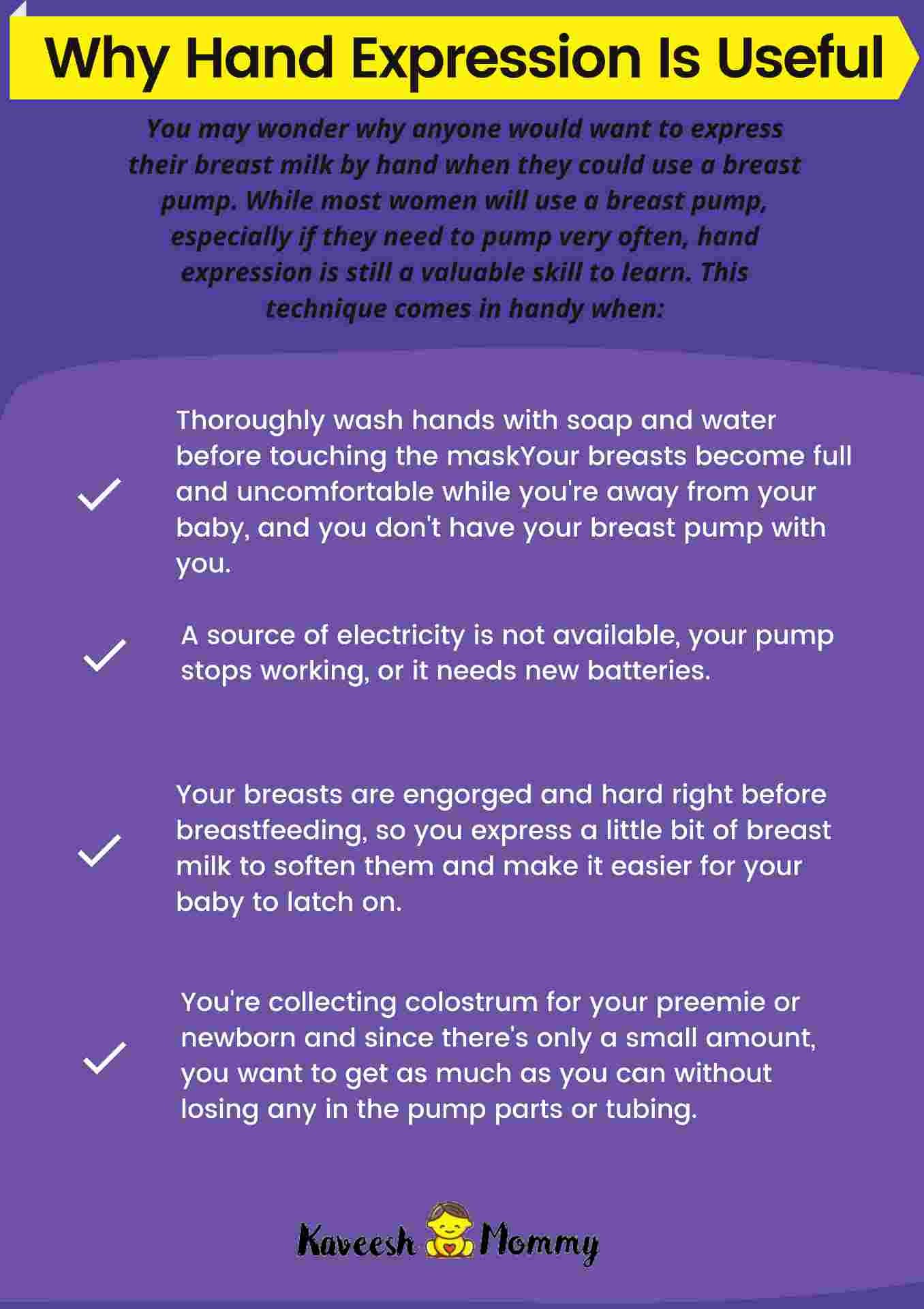
Pros and Cons of hand expression
positive reasons to learn hand expression:
- This is a natural method.
- It cost you zero.
- It does not require any machinery other than a collection jar.
- It’s is easy to learn.
- it will always available for your baby
- By using hand l make your breasts more relaxed.
few downsides to hand expression as well:
- You will have to practice how to express your breast milk manually so that you have to spend some time studying how to use your hand.
- You can use a breast pump faster and more powerful.
- Some women have issues with expressing their hands and can’t get breast milk.
When should you hand express breast milk?
The following situations are all good times for expressing breast milk for the baby:
- Mechanical breast pumps are considered to be painful and unreliable or costly by some nursing mothers. The manual expression is simpler for others – no special equipment has to be brought.
- Many mothers use hand expression to empty breast milk after using an electric pump.
- Manual expression of breast milk is also used to relieve breast engorgement.
- Many times it is extremely difficult for the baby to latch due to full breast. Then you can express a little milk to help your baby to feed,
- Sometime Premature, low-birth-weight, or sick babies are unable to suck breast milk properly then you can use hand express breast milk to help your baby.
- If a baby having a hard time getting breast milk in beginning, hand expressing breastmilk is especially important. To motivate your little one to drink, you should offer the expressed drops of colostrum (using a dropper, spoon, or small medicine cup) to your infant.
- The hand expressing your colostrum (initial milk) for a few minutes. after each feeding will provide additional stimulation to your breasts in the first 3-4 days after your baby’s birth, helping to stimulate your total supply.
For more detail and video for hand expression of breast milk see “Standford professional eduction” or watch on Venmo hand-expressing-milk
1. How long do you hand express for?
Hand expressing of breast milk, takes about 20 to 30 minutes when you are trained, the first few times normally take much longer when you become used to hand gestures.
2. How Much Milk Will I Express?
You will wonder how much breast milk you are going to produce if you start pumping or hand expressing. The good news is that most mothers give their babies the right amount of milk.
In the first week, after your milk has ‘come in’, you can expect to produce about 300–500 ml of breastmilk in 24 hours. This should increase to about 600–700 ml over the following two to three weeks. Read more about
3. How much milk should I express?
If you need to pump milk for your baby in the early days of birth, here’s a checklist for what to expect:
For instance, if a baby is unable to breastfeed, you would need to express more for your newborn infant. The amount you express for an older baby will depend on the number of times they breastfeed each day.
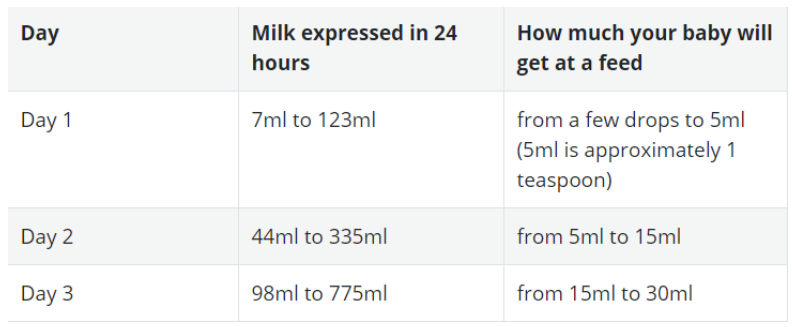
Time and practice will make it simpler and the volume of milk you express will improve.
4. How much milk should I express when away from a baby?
How much milk a baby requires differs as they get older and by weight for around one month.
- During the first week, most full-term babies take little more than 1 to 2 ounces (30 ml to 60 ml) of milk. It is because the stomachs of newborns are so thin.
- Babies achieve their optimum feeding volume of about 3 to 4 ounces (90ml to 120ml) after about 4 to 5 weeks and their maximum daily milk consumption of about 30 ounces a day (900ml).
- After 6 months, the milk consumption of your baby starts to steadily decline as you introduce solid food.
- Between the ages of 1 month and 6 months, breastfed babies take an average of 25oz (750ml) each day. Different babies drink different quantities of milk. 19oz to 30oz (570ml to 900ml) a day is a normal range of milk.
Use all these steps to decide how much breast milk your baby needs:
- Estimate how many times a day your baby breastfeeds (in 24 hours).
- Continue to split the breasts by 25oz (750ml).
- This gives you a rough guide about how much milk is released in one feeding for your exclusively breastfed baby.
Example: If a baby normally breastfeeds about 8 times a day, you may estimate that a baby can need about 94 ml (3 oz) of expressed breast milk per meal.
Note: These quantities are just a reference. If your baby is born ill or premature, you can not reach this volume. Whatever you can express is helpful for your kid. Ask Your healthcare provider will support you. Read more
5. Ways to hand express breast milk
There are three ways to express milk:
- Hand
- Hand-held breast pump
- Electric breast pump
I have explained these three ways in detail down.
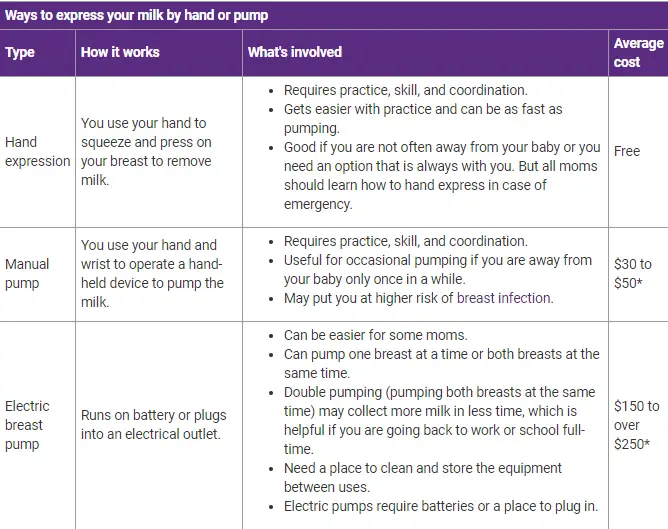
How to “express breastmilk by hand”?
Hand expression is a useful and convenient and free technique! It’s a handy way to get rid of engorged breasts. You can use it to boost milk production if you need to increase your supply to provide milk for your baby. You may also merge hand expression with pumping – learn all about pumping here.

Hand expression is easy to understand and easier to perform. Take the following steps:
- Carefully wash your hands with soap and water.
- If you want to feed it to your baby directly, you can use any clean bottle you like to collect your milk, colostrum can be expressed into a small (5ml) container or even on a teaspoon.
- Relax and get comfortable: once you are warm and comfortable, the milk can flow more freely.
- With your palm, massage your breasts, work on each nipple.
- Place the finger and thumb on either side of the nipple at the tip, softly spread and roll the nipple.
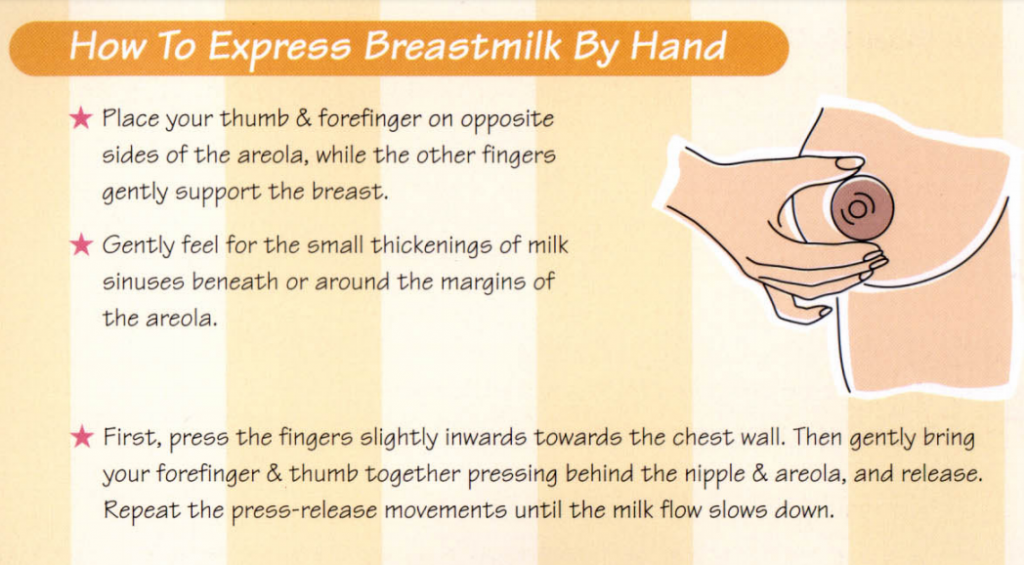
- 6. Place your thumb above your nipple at the edges of the areola (the dark region around the nipple).
- 7. Take a few deep breaths and let your shoulders fall.
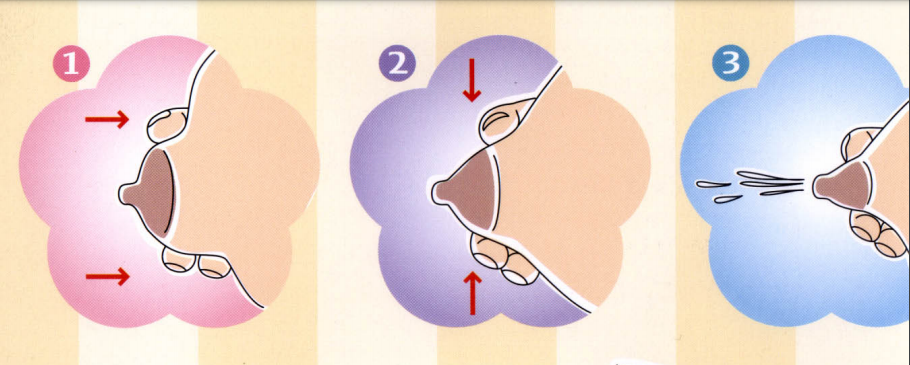
- If your baby is nearby, it can be easier to get your milk flowing if he is not trying to think about him, or looking at a photo or recording of him.
- Use your thumb and finger to softly press your breast tissue back to the wall of your chest and tighten it. While doing so, you’re going back down the milk ducts, extracting more milk (which sits in the ducts), and then squeezing it forward. Drops of milk are supposed to surface on your nipple earlier. Gently massage the first fall onto the breast. This would further enhance the let-down reflex and improve the supply of milk.
- Continuously press and squeeze in a rhythmic massaging movement. Milk will quickly continue to flow, sometimes even squirting out.
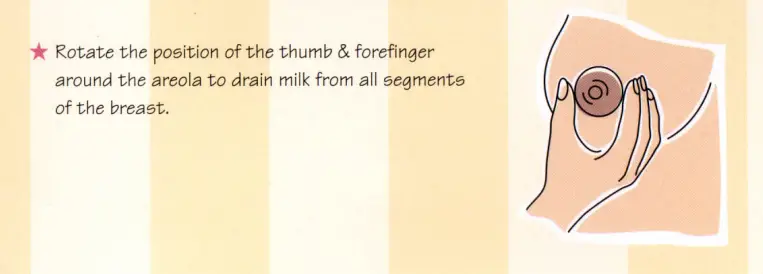
- Sometimes your hand may get tired, so change your hands around regularly.
- Bending forward with your breasts suspended means that gravity can help milk flow.
This technique is described in the book “Womanly Art Breastfeeding”
- It’s a trial and error process for most moms – an experiment to find what works best for you: when you get a milk spray from at least one nipple pore (instead of a drop or a dribble), you’ve found what works best for you.
- it may take 20 or 30 minutes for the entire process, you can always stop and start again later if you need to. Frequent short sessions are usually more effective than infrequent, longer sessions of expression.
- The expression of the hand should feel comfortable. Unless it’s adjusting what you’re doing until it feels all right.
Watch the video for hand expression of breastmilk.
How To Make Hand Expressing Easier
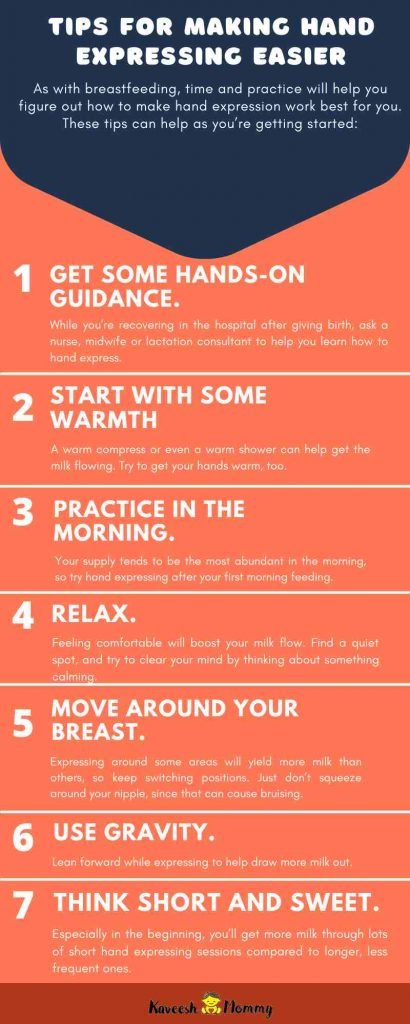
How to use pump “manual pump and electronic pump”?
Either a manual hand express or breast pump is used by many mothers. They discover it is easier and each time it produces more milk. They may also like this approach because to convey the milk, they don’t have to hold their breasts.
Follow this intrusion for handheld breast expression by pump:

- Stimulate the reaction by hand. After the milk has begun to circulate, move to the pump.
- Directly put the pump flange over your nipple and keep it tightly to your breast.
- Squeeze the pump handle rhythmically and release it. Through the collection bottle, milk will continue to flow.
- Change the suction force to make it comfortable and not cause pain or discomfort. Excess suction does not lead to extra milk removal and can lead to discomfort and nipple injury.
- Finally, express the last drop of rich milk by hand for a few moments.
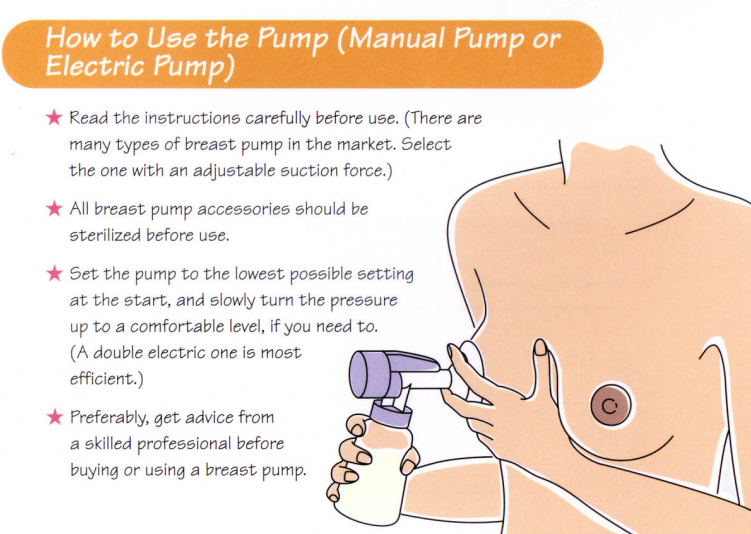
Watch the video for a better understanding.
Many breast pump models are available on the market. Some are well-conceived, some aren’t that interesting. A hand pump must be:
- Efficient
- Comfortable
- Use easily
- Safe to use – this does not affect the nipple or areola or trigger tension to the muscles
- Cost-effective.

How to store expressed breast milk?
You can store breastmilk in many different ways such as use breastmilk storage bags, which are made for freezing human milk. You can also use clean glass or hard BPA-free plastic bottles with tight-fitting lids. Do not use Recycle Number 7 containers that could contain BPA. Do not store breastmilk with disposable bottle liners or plastic bags.

How do you store breast milk in the fridge?
- After pumping each one, you can:
- At room temperature, Breastmilk is OK (up to 77°F) for up to 4 hours after pumping.
- Only refrigerate. Breastmilk is OK for up to 4 days in the refrigerator.
- Place your milk in your fridge. Freeze it immediately after breastfeeding if you’re not going to use refrigerated breastmilk within 4 days of pumping.
- Used refrigerator sacks. You should place breast milk in a fridge or insulated cooler container for up to 24 hours after breastfeeding, with ice packs. In a refrigerator, the breastmilk can be refrigerated or frozen within 24 hours.
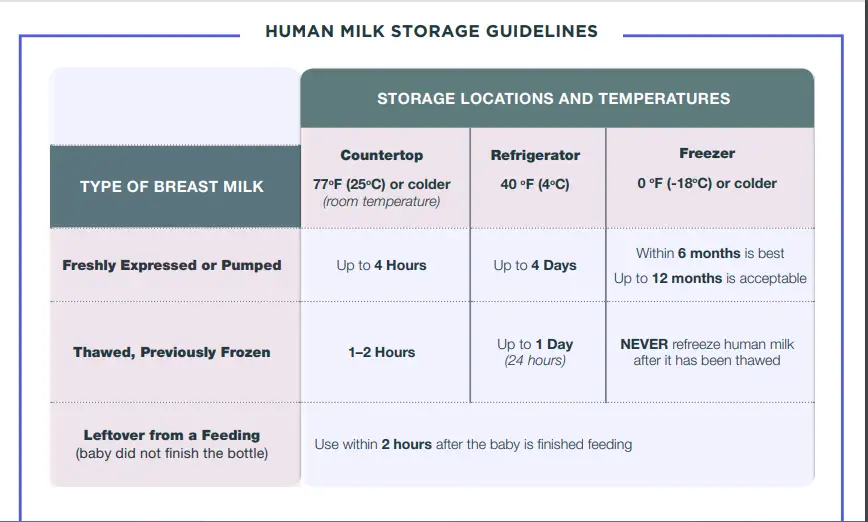
Storage: Tips for freezing milk
- Mark the milk containers specifically with the date on which the milk was expressed. Require the name of your child if you send the milk to the child care provider.
- Freeze for later feeding in small quantities (2 to 4 ounces, or 1⁄4 to 1⁄2 cups).
- Leave an inch or two from the milk to the top of the container, because when freezing, it will get higher.
- Wait until the milk is fully frozen to tighten the bottle caps.
- Store milk in the back of the fridge, not on the door of the freezer shelf so that it does not begin to thaw out.

Guide to storing fresh breastmilk for use with healthy, full-term babies
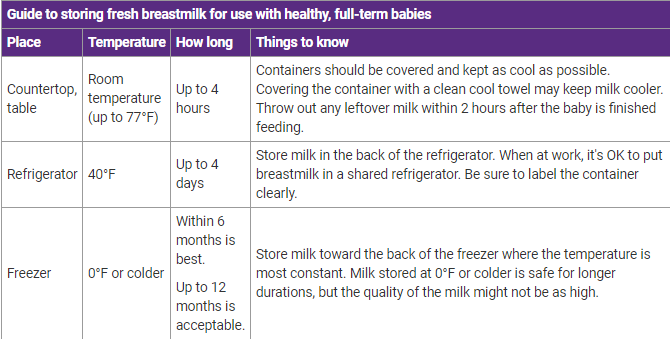
Source: Adapted from 7th Edition American Academy of Pediatrics (AAP) Pediatric Nutrition Handbook (2014); 2nd Edition AAP/American College of Obstetricians and Gynecologists (ACOG) Breastfeeding Handbook for Physicians (2014); Academy of Breastfeeding Medicine (ABM) Clinical Protocol #8 Human Milk Storage Information for Home Use for Full-Term Infants(link is external) (2017); CDC Human Milk Storage Guidelines (2018).
Storage: Tips for thawing and warming up milk

- It is not necessary to warm the breastmilk. Some moms like to serve at room temperature,
- Put the bottle or bag of frozen milk in the refrigerator overnight.
- When you plan to warm your breastmilk:
- Hold the bottle close as it heats up.
- Never put a bottle or a breastmilk bag in the microwave. Microwaving produces hot spots that could burn your baby and hurt the milk.
- Check the temperature before feeding it to your child by lowering some on your wrist. The milk is expected to feel warm, not hot.
- Use breastmilk within 24 hours of thawing it in the refrigerator.
- Once it is thawed, should not refreeze the breastmilk.

Guide to storing thawed breastmilk

Source: Adapted from ABM Clinical Protocol #8 Human Milk Storage Information for Home Use for Full-Term Infants (link is external) (2017).
Related Articles:
Hand Expressing Milk. (n.d.). Newborn Nursery. https://med.stanford.edu/newborns/professional-education/breastfeeding/hand-expressing-milk.html
How much breast milk to express. (n.d.). Www2.Hse.Ie. https://www2.hse.ie/wellbeing/child-health/expressing-breast-milk/how-much-you-need-to-express.html
Services, D. of H. & H. (n.d.). Breastfeeding – expressing breastmilk. Www.Betterhealth.Vic.Gov.Au. https://www.betterhealth.vic.gov.au/health/healthyliving/breastfeeding-expressing-breastmilk
